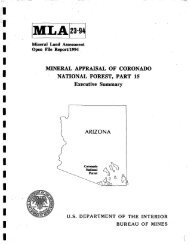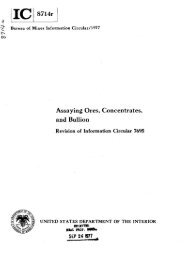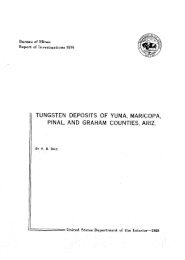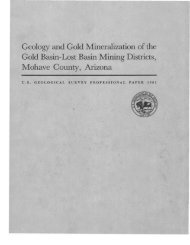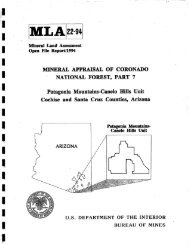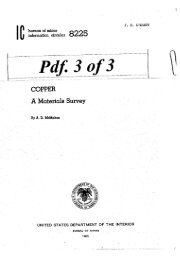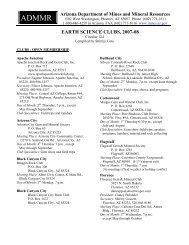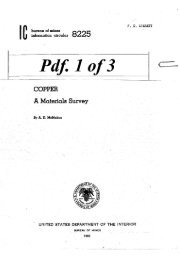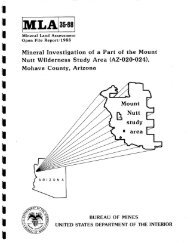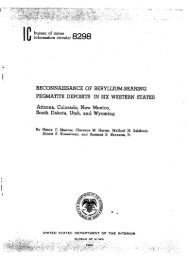here - State of Arizona Department of Mines and Mineral Resources
here - State of Arizona Department of Mines and Mineral Resources
here - State of Arizona Department of Mines and Mineral Resources
Create successful ePaper yourself
Turn your PDF publications into a flip-book with our unique Google optimized e-Paper software.
68 PRINCIPAL GOLD-PRODUCING DISTRICTS OF THE UNITED STATES<br />
Gold production <strong>of</strong> Mariposa County for 1880<br />
1959 was about 2,144,500 ounces: about 583,500<br />
ounces came from placers <strong>and</strong> about 1,561,000<br />
ounces came from lodes. Production before 1880 has<br />
not been determined.<br />
Gold mining began at an early date in the county.<br />
Gravels along Agua Fria <strong>and</strong> Mariposa Creeks<br />
were worked before 1849 <strong>and</strong> were thoroughly<br />
mined out by the hordes <strong>of</strong> prospectors who overran<br />
the area during the gold rush <strong>of</strong> 1849. By July<br />
1849 a stamp mill was processing ore from the first<br />
lode discovery in the county, the Mariposa mine on<br />
the Mother Lode (Bowen <strong>and</strong> Gray, 1957, p. 39, 43).<br />
Lode mining in Mariposa County was inhibited<br />
by the controversial Las Mariposas l<strong>and</strong> grant<br />
which gave title to 14 <strong>of</strong> the 24 miles <strong>of</strong> the Mother<br />
Lode in the county to Gen. John C. Fremont. This<br />
grant was unsurveyed <strong>and</strong> was made before gold<br />
was discovered. Long before Fremont attempted to<br />
establish his right, the grant was overrun with<br />
prospectors <strong>and</strong> miners, who underst<strong>and</strong>ably were<br />
reluctant to give up what they considered just<br />
claims. Mter years <strong>of</strong> conflict in <strong>and</strong> out <strong>of</strong> the<br />
courts, Fremont's claim to the grant was formally<br />
recognized. But by then the property was plagued<br />
by mismanagement <strong>and</strong> inefficiency <strong>and</strong> the mines<br />
never fulfilled the expectations <strong>of</strong> the authorities<br />
who evaluated them (Julihn <strong>and</strong> Horton, 1940, p.<br />
95-96).<br />
Another large estate, the Cook estate, which encompassed<br />
most <strong>of</strong> the mines along a 2-mile length<br />
<strong>of</strong> the Mother Lode in the Coulterville area, further<br />
complicated operations on the Mother Lode in Mariposa<br />
County (Julihn <strong>and</strong> Horton, 1940, p. 96-97).<br />
Despite the early frustrations, lode mining in<br />
Mariposa County flourished <strong>and</strong> was especially successful<br />
in the late 1930's <strong>and</strong> early 1940's before<br />
most <strong>of</strong> the mines closed in compliance with War<br />
Production Board Order L-208 issued in October<br />
1942. After World War II gold mining declined,<br />
<strong>and</strong> during 1950-59 the average annual gold output<br />
was less than 1,000 ounces.<br />
The western two-thirds <strong>of</strong> the county is underlain<br />
by metasedimentary rocks <strong>and</strong> metavolcanics<br />
<strong>of</strong> Paleozoic <strong>and</strong> Late Jurassic age, <strong>and</strong> the eastern<br />
one-third is underlain chiefly by intrusives <strong>of</strong> Late<br />
Jurassic or Early Cretaceous age (Bowen <strong>and</strong> Gray,<br />
1957, p. 45). The intrusive rocks consist <strong>of</strong> various<br />
types <strong>of</strong> granitic <strong>and</strong> peridotitic rocks, but biotitehornblende<br />
granodiorite is predominant.<br />
HORNITOS DISTRICT<br />
The Hornitos district, in western Mariposa<br />
County at lat 37°30' N. <strong>and</strong> long 120°14' W., is<br />
noted for gold production from both plac"rs <strong>and</strong><br />
lodes.<br />
In the early days the Quaternary grr.vels <strong>of</strong><br />
Hornitos Creek yielded considerable gold, b'1t these<br />
were nearly exhausted before 1900. The lode mines<br />
are all west <strong>of</strong> the Mother Lode, in the zone <strong>of</strong> veins<br />
referred to as the West Belt. Total production from<br />
the district is not known, but a minimum <strong>of</strong> 500,000<br />
ounces seems to be a reasonable estimate.<br />
The gold deposits <strong>of</strong> the West Belt are in veins<br />
that cut several rock types, chiefly metasedimentary<br />
rocks <strong>of</strong> the Mariposa Formation <strong>of</strong> Jurar"lic age.<br />
The Mariposa is intruded locally by serpentinized<br />
peridotite, pyroxenite, basic intrusives altered to<br />
hornblende schists, <strong>and</strong> acid intrusives such as<br />
granite <strong>and</strong> granodiorite (Julihn <strong>and</strong> Hort(J"l, 1940,<br />
p. 116-117). Most <strong>of</strong> the gold deposits al'';! along<br />
contacts <strong>of</strong> igneous rocks <strong>and</strong> metasedimentary<br />
rocks.<br />
MERCED RIVER PLACERS<br />
Quaternary gravels along the Merced River west<br />
<strong>of</strong> Bagby were a source <strong>of</strong> placer gold in the late<br />
1860's <strong>and</strong> 1870's (Bowen <strong>and</strong> Gray, 1957, p. 187),<br />
but little activity has been reported in recert years.<br />
Production from these deposits is not known, but<br />
probably was at least 50,000 ounces <strong>of</strong> gold.<br />
MORMON BA.R DISTRICT<br />
The Mormon Bar district is in T. 5 S., r.. 18 E.,<br />
about 2lh miles south <strong>of</strong> the town <strong>of</strong> Mariposa.<br />
In the early days <strong>of</strong> mining in Mariposa County,<br />
the headwaters <strong>of</strong> Mariposa Creek near Mormon<br />
Bar was the scene <strong>of</strong> considerable placer activity.<br />
By 1870, however, the deposits, which were only<br />
about 6 feet thick, were almost worked out, <strong>and</strong><br />
t<strong>here</strong>after the placer output <strong>of</strong> the entire county<br />
averaged only a few hundred ounces p"r year<br />
(Julihn <strong>and</strong> Horton, 1940, p. 159, 162). In the late<br />
1930's a slight revival took place, <strong>and</strong> the gravels<br />
at Mormon Bar were worked industriously by dragline<br />
(Julihn <strong>and</strong> Horton, 1940, p. 159). Total gold<br />
production for the district is estimated r.t about<br />
75,000 ounces.<br />
MOTHER LODE A.ND EAST BELT DISTRI0TS<br />
The Mother Lode, which has its southen terminus<br />
in Mariposa County, is a northwest-t.rending<br />
zone that is 3 or 4 miles wide <strong>and</strong> extends from the<br />
town <strong>of</strong> Mormon Bar northward through Coulterville<br />
into Tuolumne County. Roughly parallel veins<br />
east <strong>of</strong> this zone are referred to as the East. Belt.<br />
Though much has been said about the pr....duction<br />
<strong>of</strong> the Mother Lode, the mines <strong>of</strong> the East Belt <strong>and</strong>



